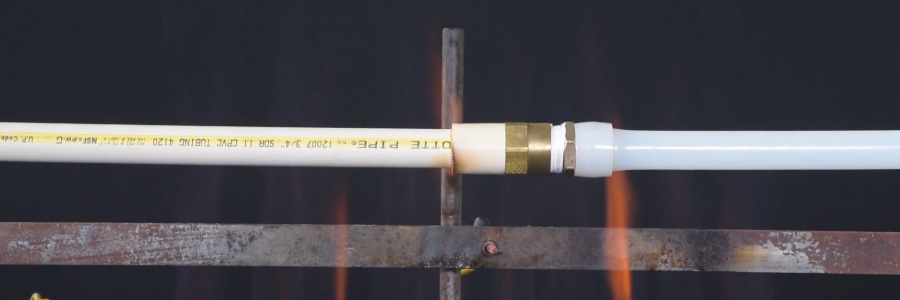
By: Jonathan Simon on January 9th, 2019
The Role of Piping Systems in Fire Risk
Fire risk is an important factor when designing piping systems for homes. That’s why piping systems should always be part of the discussion when considering combustion safety, as different types of pipes respond to fire in different ways.
Fire, Science and CPVC
Oxygen, heat and fuel must always be present for a fire to occur. Combustion just isn’t possible without sufficient oxygen.
So how do you know if a material will sustain combustion? A material’s limiting oxygen index, or LOI, is a measurement of the percentage of oxygen in the air that is required for a specific material to sustain a flame. The percentage of oxygen in the earth’s atmosphere varies but is typically about 21 percent, according to the National Weather Service. The higher the LOI, the less flammable something is.
CPVC has an LOI of 60 percent, which means that it must have more than double the percentage of oxygen that naturally occurs in the atmosphere to be able to sustain a fire. Compare this to the LOI percentages for other common household materials:
- Wooden studs: 15 percent
- PEX piping: 17 percent
- Carpet: 20 percent
- Linoleum: 40 percent
- CPVC: 60 percent
FlowGuard Gold® CPVC Piping Will Self-Extinguish
FlowGuard Gold® CPVC piping does not sustain a flame It will burn when it comes into contact with other building materials but will stop burning when the flame is removed.
This is not the case with PEX piping. During a recent test, both CPVC and PEX piping were exposed to an open flame. The CPVC pipe developed a visible char as a protective barrier on its surface, reducing the rate of burning. The PEX pipe caught fire and continued to burn to the point of dripping flaming PEX material even after the original source of the flame was extinguished. Watch a flame test with CPVC and PEX below.
What About Toxic Effects?
Testing conducted by the United States Testing Company revealed that smoke generated by CPVC is no more toxic than smoke generated by wood.
FlowGuard Gold CPVC piping – because of its high LOI – is a better choice for builders who are concerned about fire safety. CPVC is trusted in residential fire protection systems using our BlazeMaster® CPVC, FlowGuard Gold CPVC and BlazeMaster systems, which are frequently installed side-by-side in residential buildings.
FlowGuard Gold Pipe & Fittings are Listed for Use in Plenums
The following manufacturers of FlowGuard Gold CPVC pipe and fittings are listed and labeled per ICC Evaluation Service Report PMG-1264 and as required by the International Mechanical Code and Uniform Mechanical Code:
- Bow Industrial Corporation (Pipe & Fittings)
- Charlotte Pipe & Foundry (Pipe & Fittings)
- Cresline Plastic Pipe Co., Inc. (Pipe)
- NIBCO Inc. (Fittings)
All FlowGuard Gold pipe and fittings, therefore, are acceptable for use in return air plenums.
In addition, the pipe and fitting manufacturers named above are listed in ICC Evaluation Service Report PMG-1264, which states:
The following ratings were obtained and have been found to meet the 25/50 flame spread/smoke developed requirements:
- ½”-2” water-filled FlowGuard Gold CPVC pipe and fittings have a flame spread index of no more than 5 and a smoke developed index of no more than 35
- ½”-2” dry FlowGuard Gold CPVC pipe and fittings have a flame spread index of no more than 5 and a smoke developed index of no more than 25
Interested in using FlowGuard Gold CPVC as a fire safe piping system for your next build? Contact us to speak to a representative.


